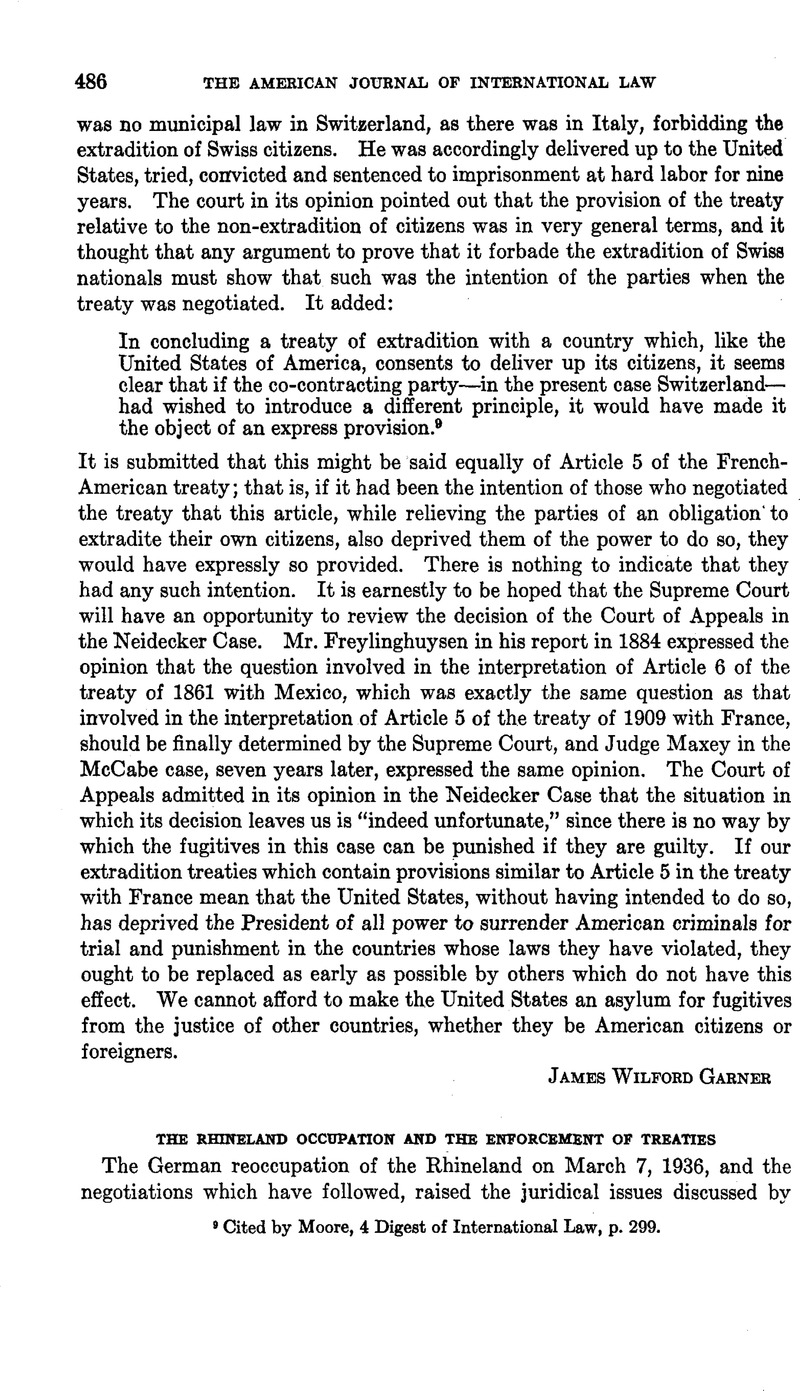Published online by Cambridge University Press: 12 April 2017

1 This Journal, April, 1936, Vol. 30, p. 265ff.
2 League of Nations, Monthly Summary, March, 1936, Vol. 16, pp. 78, 82.
3 Ibid., p. 78.
4 Ibid., p. 82.
5 The Locarno Treaties are printed in Supplement to this Journal, Vol. 20 (1926), pp. 21–33, and in International Conciliation, No. 216, January, 1926.
6 See Chancellor Hitler’s speech to the Reichstag and German Memorandum of March 7, 1936 (International Conciliation, No. 319, April, 1936, p. 165ff, and résumé of M. von Ribbentrop’s address to the League of Nations Council, March 19, 1936 (L. of N., Monthly Summary, March, 1936, Vol. 16, p. 81).
7 The Franco-Soviet Treaty is printed in International Conciliation, No. 319, April, 1936, p. 195ff. For ratification see United States Department of State, Treaty Information Bulletin, No. 78, March, 1936, p. 6.
8 L. of N., Monthly Summary, March, 1936, Vol. 16, p. 78.
9 This Journal, Supplement, Vol. 29 (1935), Part 3, Art. 27, p. 1077ff.
10 L. of N., Monthly Summary, March, 1936, Vol. 16, p. 76.
11 Supra, note 6.
12 International Conciliation, No. 216, January, 1926, p. 71ff.
13 Ibid., No. 319, April, 1936, p. 191.
14 Article 15, par. 7, reads: “If the Council fails to reach a report which is unanimously agreed to by the members thereof, other than the Representatives of one or more of the parties to the dispute, the members of the League reserve to themselves the right to take such action as they shall consider necessary for the maintenance of right and justice.”
15 Article 12 of the Covenant provides: “The report of the Council shall be made within six months after the submission of the dispute.”
16 Art. 1, supra, note 12.
17 Art. 2, supra, note 7.
18 Wright, Q., “The Test of Aggression in the Italo-Ethiopian War,” this Journal, January, 1936, Vol. 30, p. 46 Google Scholar.
19 See Conwell-Evans, T. P., The League Council in Action, 1929, p. 285 Google Scholar.
20 L. of N. Monthly Summary, April, 1935, Vol. 15, p. 84.
21 Ibid., June, 1935, Vol. 15, p. 146. See also p. 163, and French proposal, p. 114ff.
22 Wright, Q., “The Concept of Aggression in International Law,” this Journal, Vol. 29 (1935), p. 375 Google Scholar; “Collective Rights and Duties for the Enforcement of Treaty Obligations,” Proceedings, American Society of International Law, 1932, p. 108ff Google Scholar.
23 There was no collective protest of the Powers when Austria violated the Treaty of Berlin (1878) by annexation of Bosnia and Herzegovina, in 1908, though “the episode became the starting point and was in large measure the immediate cause for the series of events, all of them connected with the affairs of the Turkish Empire, which filled the years 1908 to 1914 and led directly to the World War.” (Anderson and Hershey, Handbook for the Diplomatic History of Europe, Asia and Africa, 1870–1914, Washington, 1918, p. 376.) For action in numerous instances of treaty violation, see Commentary, Draft Convention on Law of Treaties, this Journal, Supplement, Vol. 29 (1935), p. 1077ff Google Scholar; Myers, , “Violation of Treaties,” this Journal, Vol. 11 (1917), pp. 538ff, 794ff Google Scholar, Vol. 12 (1918), p. 96ff; Wright, Q., “The Effect of the War on International Law,” Minnesota Law Review, 1921, Vol. 5, p. 442ff Google Scholar.
24 See Wright, Q., “The Stimson Note of January 7, 1932,” this Journal, Vol. 26 (1932), p. 347ff Google Scholar. The doctrine stated in this note applies to executed treaties transferring territory as well as to executory treaties, while the Argentine Anti-War Treaty refers only to “territorial arrangements.”
25 Williams, John Fischer Sir, “The Permanence of Treaties,” this Journal, Vol. 22 (1928), p. 92 Google Scholar, citing Matji v. Cheong Steamship Co., L. R. 1926 A.C. 497, 509; McNair, A. D., “The Function and Differing Legal Character of Treaties,” British Year Book of International Law, 1930, p. 110 Google Scholar.
26 Tobin, H. J., The Termination of Multipartite Treaties, 1933, p. 283ff Google Scholar.
27 Wright, Q., “Article 19 of the League of Nations Covenant and the Doctrine Rebus Sic Stantibus,” Proceedings, American Society of International Law, 1936, p. 55 Google Scholar.